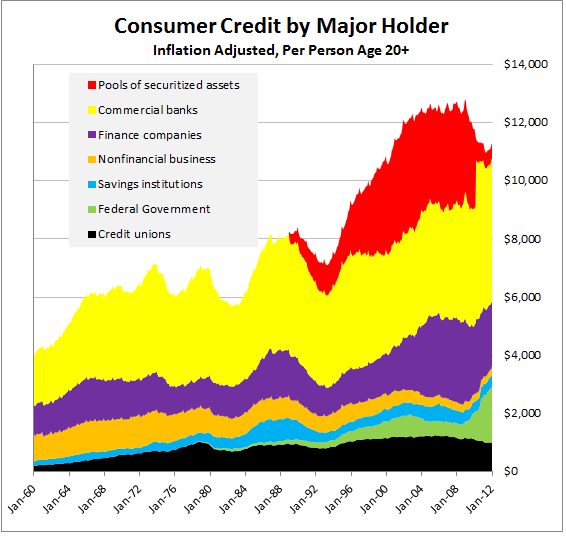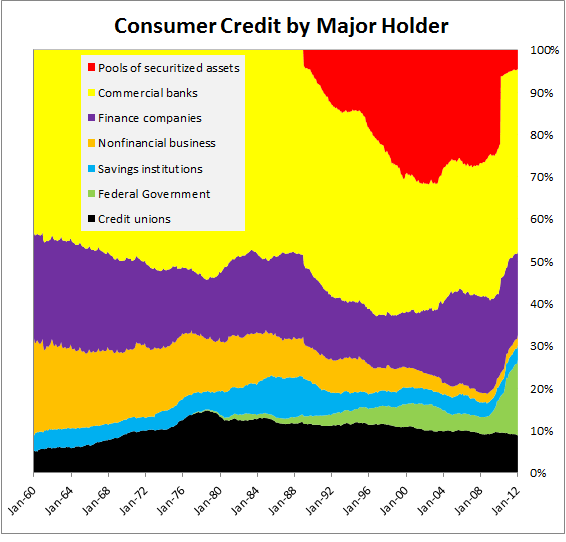At the?height?of the credit bubble in December 2008 the amount of consumer debt outstanding per person, age 20 and above*, stood at $12,811, over twice the inflation adjusted amount it was just 25 years prior.
Where did the rapid increase in consumer credit that began 1984 come from and what type of institutions were on the other side of the debt?
Consumer credit covers most short and intermediate-term credit extended to individuals,?excluding loans secured by real estate. It includes automobile loans, credit cards, personal loans, student loans, and loans for boats, trailers and?mobile homes. These loans may be secured or unsecured, revolving or non-revolving.
- Commercial?Banks: Credit from commercial banks has ebbed and flowed over the past 30 years based on the health of the economy, but, adjusting for inflation, it usually?accounts?for about $4,000 per person. So this does not fully explain the expansion.
- Savings Institutions: In the mid 1980s, savings institutions expanded their lending, but then returned to historical norms after the Savings and Loans crisis at the end of the decade. Another dead end as to the source of the?extraordinary?growth in consumer credit.
- Credit Unions:?Credit from credit unions actually declined on an inflation adjusted, per person basis over the past thirty years.
- Non-financial businesses (retailers): Credit from non-financial businesses?also?declined over the past thirty years on an inflation adjusted, per person basis.
- Federal Government: There was an expansion in consumer credit by the Federal government , from levels close to $0 in 1977, but up until 2009, accounted for very little of the overall debt.
- Finance Companies: One major source was the additional levels of credit extended by finance companies. Adjusted for inflation, there was $1,150 of credit per person in May 1984. By December 2008 this figure had swelled to $2,843
- Pools of Securitized Assets: The biggest source of the additional?consumer credit in the late 1980s, 1990s and 2000s was from pools of securitized assets, also known as asset-backed-securities. Virtually non-existent?as a source of consumer credit in 1984, by December 2002 there was $3,889 outstanding per person. A source of ?shadow bank? lending, securitized assets are a collection of consumer loans packaged primarily by?commercial?banks and finance companies and then sold to investors and other banks. Prior to 2010 banks did not have to report securitized assets on their balance sheet. However, due to an accounting rule change in early 2010 banks had to start including the securitized assets that they held. This?accounting?rule change explains the spike in?commercial?bank sourced credit in early 2010.

Data Source: Federal Reserve After declining?precipitously?from it?s December 2008 peak, consumer credit outstanding per person started to increase again in May 2011. A majority of the increase has come from the expansion of consumer credit (namely student loans) by the federal government.
*Due to data limitations, for the purposes of this analysis, it is assumed that individuals age 19 and below do not hold any consumer debt.
Comments are closed.
Source: http://www.valeofinancial.com/2012/03/where-does-consumer-credit-come-from/
2012 dunk contest edgar vs henderson berkshire hathaway ufc 144 james jones james jones tony parker

কোন মন্তব্য নেই:
একটি মন্তব্য পোস্ট করুন